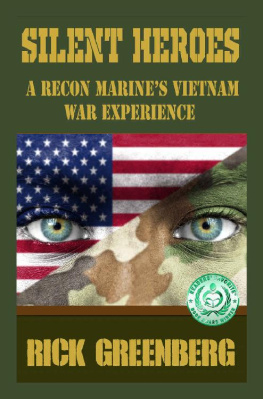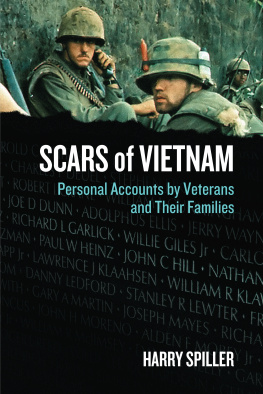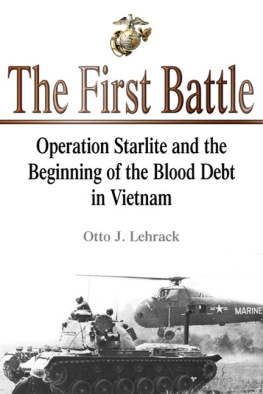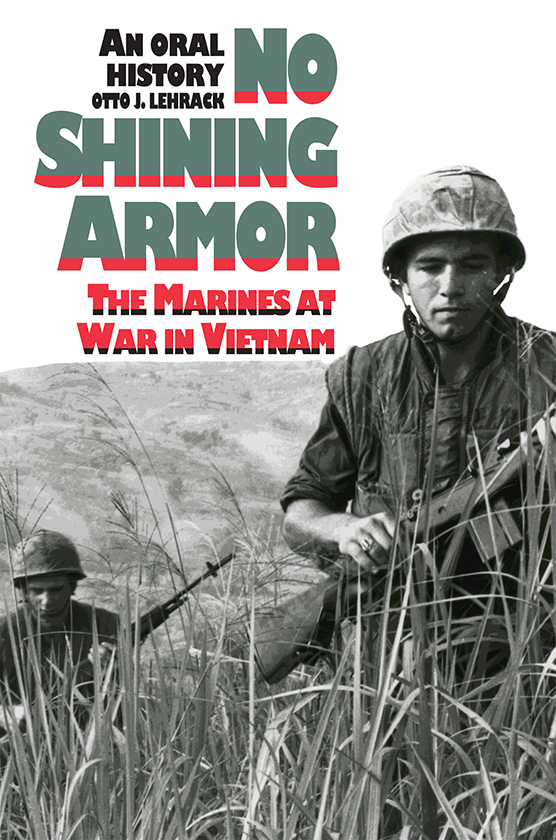Table of Contents
NO SHINING ARMOR
MODERN
WAR
STUDIES
Theodore A. Wilson, General Editor
Raymond A. Callahan
J. Garry Clifford
Jacob W. Kipp
Jay Luvaas
Allan R. Millett
Series Editors

NO SHINING ARMOR
THE
MARINES
AT WAR IN
VIETNAM
AN ORAL HISTORY
OTTO J. LEHRACK
University Press of Kansas
1992 by the University Press of Kansas
All rights reserved
Maps and photographs not otherwise credited are courtesy of the United States Marine Corps, which has granted permission for their use.
Published by the University Press of Kansas (Lawrence, Kansas 66045), which was organized by the Kansas Board of Regents and is operated and funded by Emporia State University, Fort Hays State University, Kansas State University, Pittsburg State University, the University of Kansas, and Wichita State University
Library of Congress
Cataloging-in-Publication Data
No shining armor : the Marines at war in Vietnam: an oral history / [edited by] Otto J. Lehrack
p.cm. (Modern war studies)
Includes bibliographical references and index.
isbn 978-0-7006-0533-0 (alk. paper). isbn 978-0-7006-0534-7 (pbk. : alk. paper)
isbn 978-0-7006-2880-3 (ebook)
1. Vietnamese Conflict, 19611975Regimental historiesUnited States. 2. United States Marine Corps. Division, 3rd. Battalion, 3rdHistory. I. Lehrack, Otto J. II. Series.
ds 558.4. n 61992
959.704'3373dc2091-39414
Printed in the United States of America
10 9 8 7 6 5 4
The paper used in the print publication meets the minimum requirements of the American National Standard for Permanence of Paper for Printed Library Materials z 39.48-1984.
FOR KAREN
wife, lover, editor, and best friend
grunts
Beasts of burden sloppily loaded
with personal belongings and tools
of modern mayhem, walk, head down,
bodies scarred and eroded
by overwork, lack of sleep and
exposure to natures cruel edges.
Banded together by cramps,
cuts, sores, sweat, and the everpresent threat
of death so pervasive that it
can only be coped with by deriding it.
No shining armor a flak vest.
No bright colors or plumes, but leaf patterns.
No rest, no wine, no end
to gripping the ground and
waiting for the round.
April 1969
Major General Richard C. Schulze, USMC,
who commanded the 3d Battalion, 3d
Marines, in Vietnam in 1969
CONTENTS
MAPS AND ILLUSTRATIONS
maps
photographs
PREFACE
At the time I decided to do this book, I was collecting material for another work. The collection effort brought me in contact with T.J. Kelly, a former Marine with whom I had served in Vietnam. Kelly had begun searching for some of his former comrades from Vietnam and had found several hundred men who had been there with the 3d Battalion, 3d Marines, our battalion. He was kind enough to share his list with me and to keep me updated on new additions.
After talking to just a few of these men I realized that no one had adequately told what it was like to be a grunt in Vietnam. At this point I put my original project aside and began a five-year task of contacting the Marines and sailors of the 3d Battalion, 3d Marines (3/3), and asking them to record their impressions of the war.
Some welcomed the opportunity. For others, the experiences of Vietnam, and the years after, were so traumatic that even twenty years later, it was still too emotional an issue for them to talk about. Some wept as they recounted their tales.
This work is a product of their collective memories. It is an oral history. The vast majority of the material herein originated in oral tapes that were recorded specifically at my request for this project between 1986 and 1990, in most cases more than twenty years after these men had left the war. A few were recorded during the war and survived until the present. Most were done by individuals, but some were recorded in pairs or small groups. The taped material is supplemented in a very few cases with thoughts from letters and telephone calls. As with any history project, the raw material greatly exceeded what remains in the final product. The nearly three thousand pages of data I received from individual contributors were heavily edited and distilled. My objective in this process has always been to present a coherent and accurate account of what the infantry experience was really like in the eyes of the men who lived it. If, through the editing process, I strayed from that goal or the intentions of any participant, it was not purposeful, but I accept full responsibility.
To provide a framework for the personal material, I used 3/3s official Command Chronologies, which were declassified in 1988. Finally, I supplemented this work with information provided by other scholars. I tried to provide additional information only in those instances where it was necessary for an understanding of what was happening at the small-unit level.
These men chose me, rather than the other way around. I contacted every member of the battalion that I could find during these five years and asked them to participate. Every one who agreed to do so is here. The more articulate and introspective are obviously overrepresented in terms of volume. But, again, my intent was to help them all relay their most important thoughts about the war to the world. All ranks are represented, and all the larger minority groups.
Although the words on these pages came from the members of a single Marine infantry battalion, they are representative of the experiences of all those who served in infantry battalions in Vietnam. I chose this battalion for the best of reasons. It was the unit in which I served, first as S-4 (logistics officer) and later as the commanding officer of India Company, in my first Vietnam tour in 196768. Therefore, some of the men of 3/3 had known me in Vietnam, others knew of me, and the rest learned that I had served in combat with their battalion. This led them to trust me to organize their experiences in such a way that outsiders might begin to understand.
This reason aside, the 3d Battalion, 3d Marines, is an ideal representative of the infantry experience of the Vietnam War. Neither the first battalion to land nor the last to leave, it fought in every section of I Corps in its more than four years of service there. Landing on the beaches of Chu Lai in 1965, it provided security for the construction of the airstrip. It lost its innocence in the first big operation of the war, S tarlite , where one of its members, Robert OMalley, became the first Marine to be awarded the Medal of Honor in Vietnam.
The 3d Battalion, 3d Marines, went on to Hill 55, west of Danang, where its commander, Lieutenant Colonel Joseph Muir, was the first battalion commanding officer (CO) that the Corps lost in Vietnam. It participated in the pacification effort by building churches and schools and providing medical care to Vietnamese civilians. In Danang in 1966 the battalion witnessed the Buddhist protests and the divisive splits in the South Vietnamese Army.
Moving later that year to Northern I Corps, it contested control of the Demilitarized Zone with North Vietnamese regulars, a sophisticated, well-trained foe often supported by heavy artillery. Finally, in late 1969, as part of the Vietnamization of the war under President Nixon, it was withdrawn.









